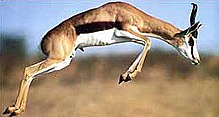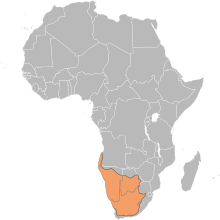Springboks
| Springboks | ||||||||||||
|---|---|---|---|---|---|---|---|---|---|---|---|---|

Kalahari springbok ( Antidorcas hofmeyri ) in Namibia |
||||||||||||
| Systematics | ||||||||||||
|
||||||||||||
| Scientific name | ||||||||||||
| Antidorcas | ||||||||||||
| Sundevall , 1847 |
The springboks ( Antidorcas ) are an African genus of antelope from the gazelle-like group . Today they are found only in southern Africa, but fossil finds show that springboks were originally much more widespread in Africa. There are three types.
features
The springboks reach a head-torso length of 112 to 162 centimeters, a shoulder height of up to 90 centimeters and weigh between 27 and 59 kilograms. The horns are up to 43 centimeters long.
Springboks are reminiscent of the Thomson gazelle . Like these, they have a dark, red-brown stripe that separates the yellow-brown top from the white belly side. On the white head, a thin strip extends from the eyes to the upper corner of the mouth. The elongated back hair can only be seen when the animal “shows off”, that is, jumps up with stiff legs and curved back - the behavior that gives it its name. Both sexes have curled, lyre-shaped horns; however, those of the females are slimmer.
The shape resembles that of a real gazelle . The springbok are still assigned to a different genus, as their teeth differ from those of the gazelles: they usually have only two premolars in both the upper and lower jaw , while gazelles have three. If the second premolars appear, they are extremely small in shape.
Way of life
The name "springbok" comes from the vertical sentences with which this antelope soars when it is frightened. These jumps from a standing position can reach heights of 3.5 m. During this "show off", as bouncing is also called, the legs remain stiff, the back is arched outwards, and the long, white hair protrudes from a fold of skin in the back and can be seen from afar . This behavior could serve to warn the conspecifics if a predator has been seen. However, young animals in the game also make these jumps again and again. An alternative hypothesis is that the signals are intended for the predators themselves: they are shown that they have been noticed and that there is no point in attacking them. Should an attack occur, a springbok can flee at a speed of almost 90 km / h. This makes it one of the fastest mammals, alongside the cheetah , the pronghorn and the stag goat antelope . However, it is considered to be the fastest land animal and already reaches 62 km / h after two seconds.
During the dry season, springboks live in smaller groups that combine to form huge herds in the rainy season. These herds, in which the animals migrate for better food sources, could contain over a million animals in earlier centuries. Today the largest herds consist of around 1,500 springboks. In the dry season, the females and their young form small herds of around a hundred animals. Separate herds form young males; these bachelor associations consist of about fifty animals. Males are territorial. They maintain territories with an area of 10 to 40 hectares and try to keep the females there.
distribution

The genus occurs in the territories of South Africa , Namibia , Angola and Botswana . The habitat is the open savannah .
species
Today there are three types:
- Angola springbok ( Antidorcas angolensis Blaine , 1922)
- Kalahari springbok ( Antidorcas hofmeyri Thomas , 1926)
- Cape springbok or springbok ( Antidorcas marsupialis ( Zimmermann , 1780))
Others
In international sports competitions, South African teams often name themselves after these animals; This is the name of the successful national rugby team in South Africa " the Springboks ". This connection with the springbok is waning, however, as the antelope is linked to the coat of arms of the old apartheid state in the consciousness of the new South Africa . In 1997 , South African Airways removed the springbok from their logo; springbok , however, is still the ICAO callsign, ( callsign ) of the airline. There are also attempts to keep wild animals in South Africa using springboks. The meat is marketed in Europe, among other places.
Since the South African sculptor Coert Steynberg designed the springbok motif for coinage, the springbok has enjoyed increasing popularity. In July 1967 this springbok motif was combined with the portrait of the nature lover Paul Krüger on the successful gold investor coin Krugerrand . This made the springbok motif known worldwide. Every year more and more coins are minted with the springbok motif, u. a. the silver ounce with the name THE AFRICAN SPRINGBOK . The springbok is one of the most popular animal motifs today.
Despite this fame, the springbok have long been massively hunted. On the one hand their meat was valued, on the other hand they were thought to be a pest because the herds trampled the grain fields. Organized mass shootings even succeeded in the 19th century in making the springboks extinct in South Africa; in the 20th century, however, the animals were reintroduced from neighboring countries. The total population is now estimated at 600,000 animals.
literature
- Colin P. Groves and David M. Leslie Jr .: Family Bovidae (Hollow-horned Ruminants). In: Don E. Wilson and Russell A. Mittermeier (eds.): Handbook of the Mammals of the World. Volume 2: Hooved Mammals. Lynx Edicions, Barcelona 2011, ISBN 978-84-96553-77-4 , pp. 444-779
- John D. Skinner: Genus Antidorcas Springbok. In: Jonathan Kingdon, David Happold, Michael Hoffmann, Thomas Butynski , Meredith Happold and Jan Kalina (eds.): Mammals of Africa Volume VI. Pigs, Hippopotamuses, Chevrotain, Giraffes, Deer and Bovids. Bloomsbury, London, 2013, pp. 398-403
- CA Spinage: The Natural History of Antelopes . Croom Helm, London 1986, ISBN 0-7099-4441-1
Single receipts
- ↑ Spinage, p. 189
- ↑ John D. Skinner: Genus Antidorcas Springbok. In: Jonathan Kingdon, David Happold, Michael Hoffmann, Thomas Butynski, Meredith Happold and Jan Kalina (eds.): Mammals of Africa Volume VI. Pigs, Hippopotamuses, Chevrotain, Giraffes, Deer and Bovids. Bloomsbury, London, 2013, pp. 398-403
- ↑ Spinage, p. 166
Web links
- Antidorcas marsupialis in the endangered Red List species the IUCN 2006. Posted by: Antelope Specialist Group, 1996. Retrieved on 11 May, 2006.


